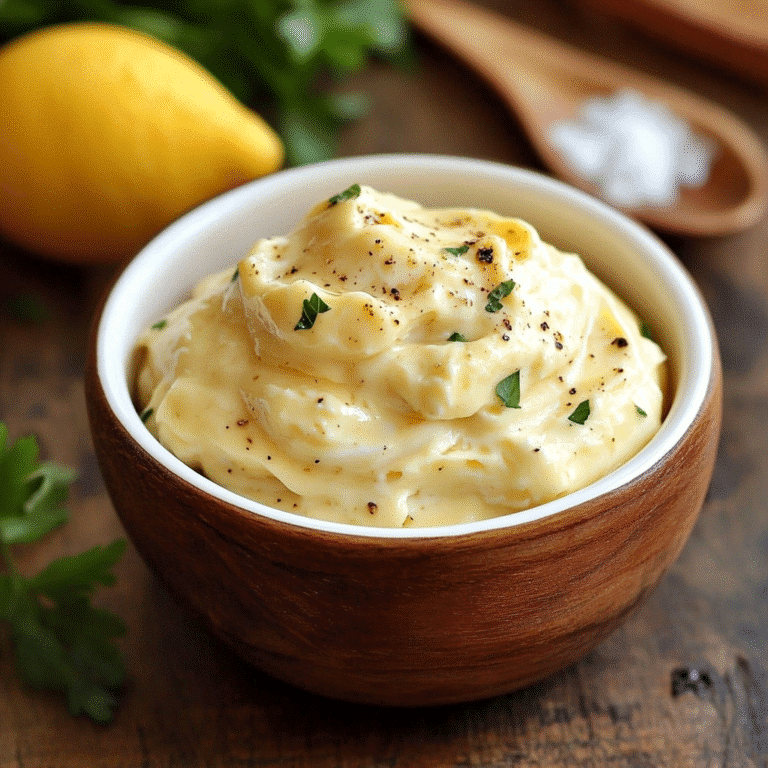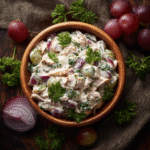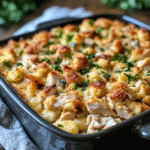Have you ever thought about mixing up your classic mayo recipe using fried eggs instead of raw ones? It may sound a bit offbeat, but the idea of fried egg mayonnaise has taken over social media and sparked curiosity in kitchens across the world. Whether you’re worried about raw eggs or just love experimenting with flavor and texture, this wild twist might just be your next favorite condiment.
In this article, we’ll break down everything you need to know—from what it is and how it compares to classic mayonnaise, to step-by-step instructions and creative ways to use it. We’ll also tackle frequently asked questions like “Can I make mayonnaise with cooked eggs?” and “How do I make mayo with just egg and oil?”
What Is Fried Egg Mayonnaise?
Understanding the Concept of Fried Egg Mayonnaise
At its core, mayonnaise is an emulsion—oil and egg whipped together until smooth and creamy. Traditionally, it’s made with raw egg yolks. But with fried egg mayonnaise, you’re using cooked eggs, particularly fried ones, to achieve a surprisingly rich and hearty spread.
So why do it? First, it reduces the risk of foodborne illness from raw eggs. Second, frying the egg develops flavor—think of those golden, crispy edges and savory notes that raw eggs just don’t offer. Lastly, it’s just plain fun to experiment.
Think of it as a fusion between traditional mayo and egg salad. The texture is a little chunkier, more rustic, and the taste has a slight umami hit from the cooked yolks and browned whites.
Don’t miss our smashed potato sheet pan recipe—they’re the perfect crispy companion to fried egg mayonnaise.
How It Differs from Traditional Mayonnaise Recipes
The difference lies in two things: texture and taste. Traditional mayo is ultra-smooth and pale. It blends raw yolks with oil to form a silky, spreadable condiment.
Fried egg mayonnaise, however, brings:
| Feature | Traditional Mayonnaise | Fried Egg Mayonnaise |
|---|---|---|
| Egg State | Raw yolks | Cooked (fried) whole eggs |
| Flavor | Neutral, eggy | Rich, savory, toasted |
| Texture | Smooth and light | Chunky or creamy (your choice) |
| Food Safety | Raw egg concerns | Safer due to cooking |
The oil-to-egg ratio also shifts a little, and since the yolks are already partially “set” from cooking, the emulsion behaves differently. Still, with a bit of blending and patience, you can achieve a delightful mayo that’s rich, spreadable, and bold in flavor.
Print
Fried Egg Mayonnaise
- Total Time: 15 minutes
- Yield: 6 tablespoons
Description
This Fried Egg Mayonnaise is a bold, creamy, and fully-cooked twist on the classic condiment. Made by blending golden fried eggs with oil and seasonings, it delivers a rich, savory flavor with zero raw egg risk. Perfect as a sandwich spread, dip, or salad enhancer—this fried egg mayonnaise hack is both delicious and safe.
Ingredients
- 2 large eggs, fried (yolks soft-set)
- ¾ cup neutral oil (like sunflower or canola)
- 1 teaspoon Dijon mustard
- 1 teaspoon lemon juice or white vinegar
- ¼ teaspoon salt (adjust to taste)
- Optional: garlic, sriracha, fresh herbs for variations
Instructions
- Fry the Eggs: In a non-stick pan over medium heat, fry 2 eggs until the whites are set and the yolks are soft. Remove and let cool for 5–10 minutes.
- Prepare the Base: Roughly chop the cooled eggs and place them into a food processor or blender jar.
- Add Flavors: Add Dijon mustard, lemon juice, and salt to the eggs. Blend for a few seconds to break down the texture.
- Create the Emulsion: With the processor running, slowly drizzle in the oil. Blend until the mixture turns creamy and smooth.
- Adjust & Store: Taste and adjust seasoning. If too thick, add a few drops of water. Store in an airtight container in the fridge for up to 3 days.
Notes
Make sure the fried eggs are not too hot when blending, or the mayo could split. For a spicier version, blend in a teaspoon of sriracha. For a smoother texture, use only yolks and discard the whites. Serve with toast, roasted potatoes, or sandwiches.
- Prep Time: 10 minutes
- Cook Time: 5 minutes
- Category: Condiment
- Method: Blended
- Cuisine: Homemade Fusion
Can You Make Mayonnaise with Fried Eggs?
Exploring the Science Behind Mayonnaise with Cooked Eggs
Traditional mayonnaise relies on raw egg yolks to emulsify oil and create that creamy, spreadable consistency. The proteins in raw egg yolks are perfect emulsifiers—they bind oil and water together so they don’t separate. But what happens when you cook those yolks first—say, by frying them?
When eggs are fried, the proteins denature, meaning they change structure. This process limits their emulsifying power. However, you can still achieve a surprisingly smooth and flavorful result by:
- Finely chopping or blending the fried egg.
- Adding a binding agent like mustard or vinegar.
- Gradually mixing in oil using a food processor or immersion blender.
While the emulsion isn’t as “perfect” as raw-egg mayo, it still holds together well enough for spreads and dips. Plus, it’s a safer alternative for folks who are pregnant, immunocompromised, or simply uncomfortable with raw eggs.
So yes—you can make mayonnaise with fried eggs, but it’s not the same as classic mayo. Think of it as a rustic, savory cousin that’s got some character.
What Experts and Chefs Say About Using Fried Eggs
According to culinary communities and experimental chefs, fried egg mayo is more than just a TikTok gimmick—it’s a legitimate kitchen trick.
One Reddit user on r/Cooking notes that “any type of cooked egg may be blendable, resulting in a sauce that tastes good, but it won’t be mayonnaise.” This view reflects the general consensus: while it mimics mayo, it’s technically not a true emulsion. Yet, that doesn’t stop people from loving it.
Chef @dobrovolskyichef on TikTok tried it with viral success, blending fried yolks with mayo, mustard, and chopped whites for a chunky yet creamy texture. The result? A zesty, hearty spread that works wonders on breakfast sandwiches and toast.
Many pro chefs suggest adding extra oil slowly while blending, or incorporating a spoonful of regular mayo to stabilize the mix. This bridges the gap between homemade creativity and functional chemistry.
Ingredients You’ll Need for Fried Egg Mayonnaise
Essential Ingredients: From Eggs to Oil
To make delicious, creamy fried egg mayonnaise, you don’t need a long list of gourmet items. In fact, the base recipe uses simple ingredients you probably already have at home.
Here’s what you’ll need:
| Ingredient | Purpose | Notes |
|---|---|---|
| Fried Eggs | Base flavor & emulsifier | Cook until yolk is set but soft |
| Neutral Oil | Creates the emulsion | Use canola, sunflower, or light olive oil |
| Lemon Juice or Vinegar | Adds acidity to balance flavor | White vinegar or fresh lemon both work |
| Salt | Enhances flavor | Adjust to taste |
| Mustard (optional) | Helps stabilize emulsion & adds depth | Dijon or yellow mustard |
The real key here is the fried egg—you want the yolk to be cooked but not overdone. A slightly jammy yolk blends more smoothly, while overcooked eggs can result in a gritty texture.
Tip: Pro tip: For a smooth, even texture, blend using a food processor or an immersion blender. Hand-whisking may not break down the fried egg enough to get that smooth, mayo-like feel.
Optional Add-Ins for Flavor Boost (Garlic, Mustard, Vinegar)
Once you’ve nailed the basic combo of fried egg, oil, and vinegar or lemon juice, it’s time to level up your flavor game.
Here are some flavorful add-ins you can experiment with:
- Garlic: A small clove, minced or roasted, adds a punch of savory richness.
- Sriracha or Hot Sauce: For a spicy kick—great in sandwich spreads.
- Smoked Paprika: Infuses the dish with rich flavor and a gentle hint of smoke.
- Dijon Mustard: Helps with emulsification and gives tangy balance.
- Fresh Herbs: Chives, dill, or parsley can turn your mayo into a herbaceous spread.
The beauty of fried egg mayonnaise is its flexibility. Whether you want something bold and spicy or mellow and creamy, the ingredients are entirely up to you.
Step-by-Step Guide to Making Fried Egg Mayonnaise
Preparing the Fried Eggs the Right Way
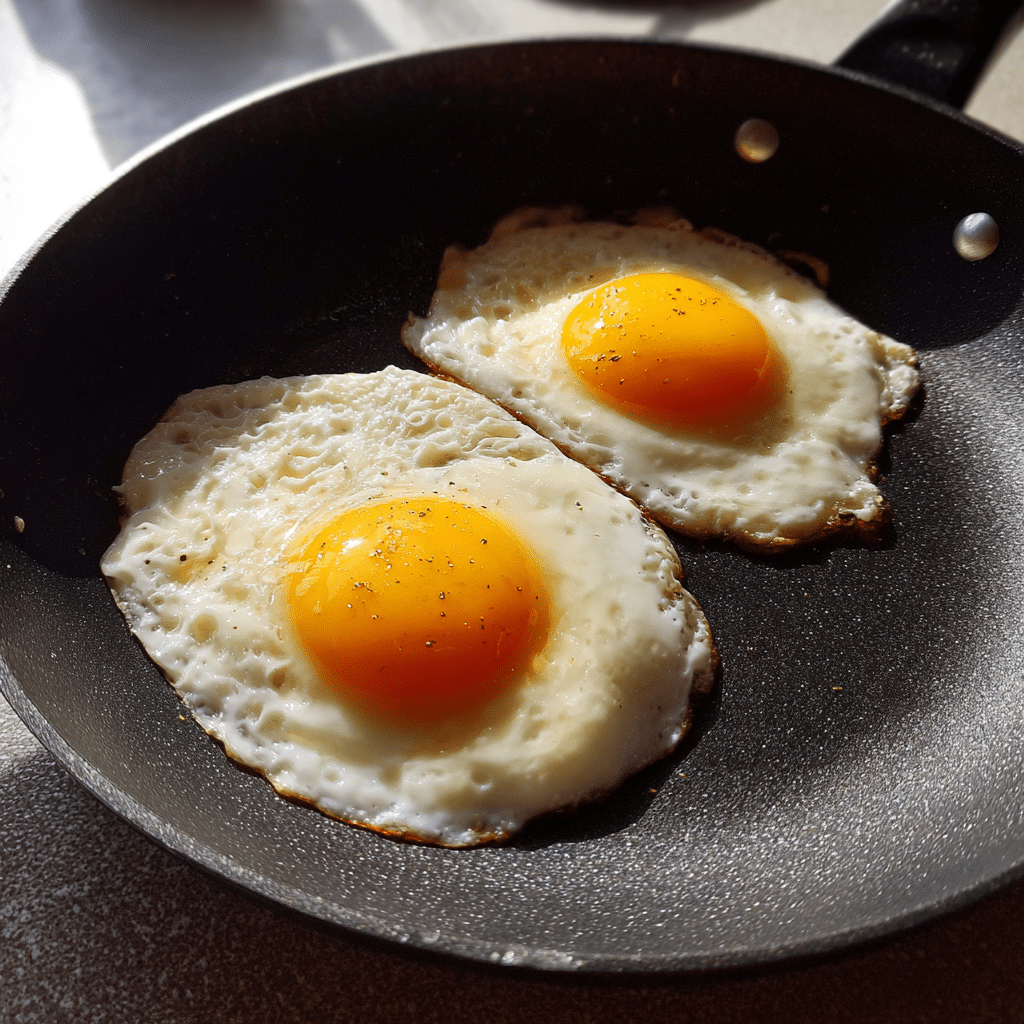
Before you start blending, you need to get your fried eggs just right. The way you fry them makes a big difference in both texture and flavor. Here’s how to do it:
Step-by-Step Egg Prep:
- Choose Fresh Eggs – The fresher the egg, the richer the yolk.
- Warm a non-stick skillet with a light coating of neutral oil over medium heat.
- Crack and Fry – Fry 2 large eggs until the whites are firm and the yolks are set but still soft in the center (sunny-side up or over medium works well).
- Cool Them Down – Remove from heat and let them cool for 5–10 minutes. This prevents the mayo from breaking during blending due to excess heat.
Tip: Avoid crispy or browned yolks—those can cause a bitter aftertaste in the final spread.
Once cool, you’re ready to start blending.
Blending Fried Eggs with Oil to Create the Perfect Emulsion
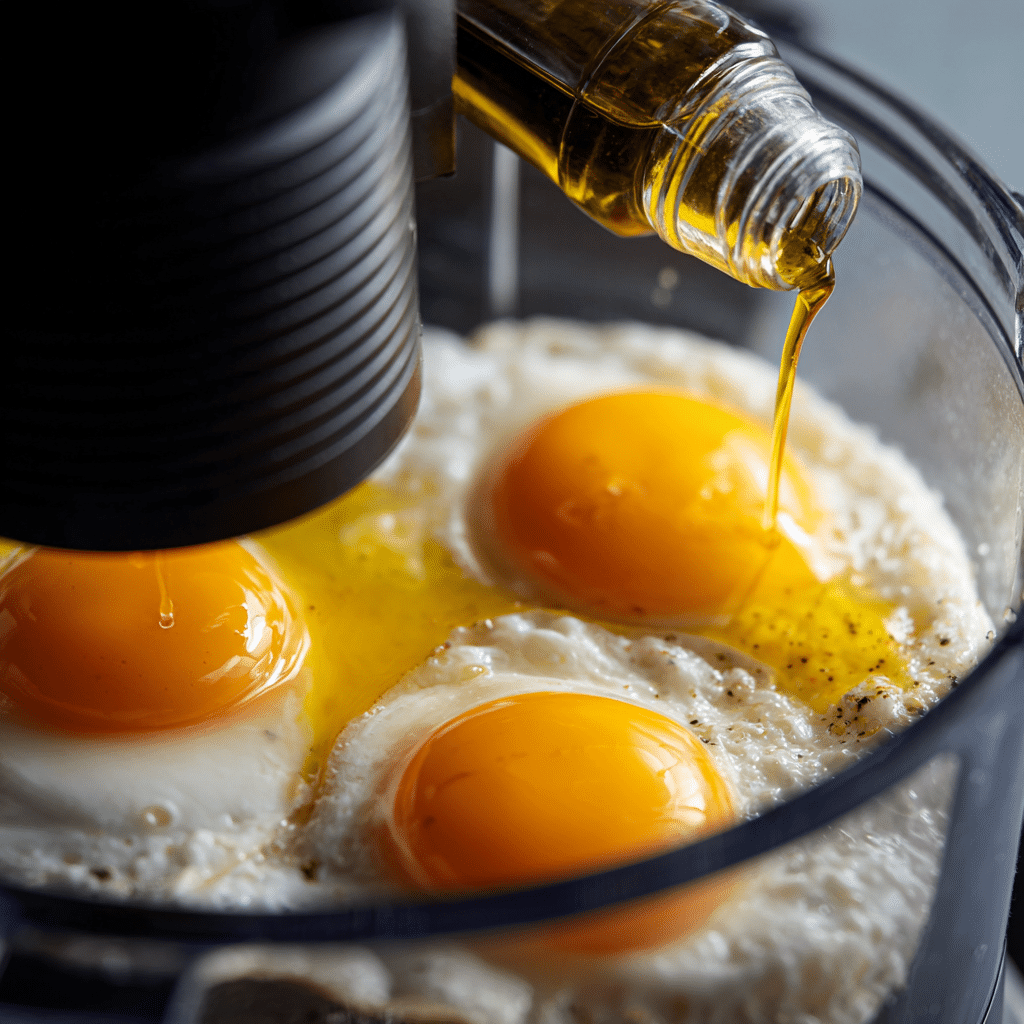
With your fried eggs ready, let’s turn them into mayo.
Ingredients Recap:
- 2 fried eggs (cooled)
- ¾ cup of neutral oil, such as canola, sunflower, or light olive oil.
- 1 tsp Dijon mustard (optional but helps stabilize)
- 1 tsp lemon juice or vinegar
- Salt to taste
Blending Instructions:
- Chop or Break the Eggs – Roughly chop fried eggs and add them to your food processor or mixing jar.
- Add Acid & Mustard – Pour in lemon juice/vinegar and mustard. These help with emulsification.
- Begin blending by pulsing briefly to break up the eggs.
- Slowly stream in the oil as you blend — this steady addition is essential for a smooth, stable emulsion.
- Season – Add salt to taste. Optional: mix in garlic, herbs, or spices.
Consistency Check: The final mayo should be thick enough to spread but soft enough to spoon. If it’s too runny, blend in more egg. Too thick? Mix in a few drops of water or an extra splash of lemon juice.
Storage: Keep in an airtight container in the refrigerator for up to 3 days. Since it’s made with cooked eggs, it’s safer than traditional raw-egg mayo, though it’s still best when fresh.
Popular Variations of Fried Egg Mayonnaise
Spicy Fried Egg Mayonnaise with Sriracha
If you enjoy punchy, intense flavors, this variation is sure to impress. Spicy fried egg mayonnaise takes the rich base of fried eggs and kicks it up with just the right amount of heat.
Here’s how to make it:
- Base Recipe: Start with the standard fried egg mayonnaise blend.
- Add Heat: Mix in 1–2 teaspoons of Sriracha, chili garlic sauce, or your favorite hot sauce.
- Boost the flavor with a hint of smoked paprika and a touch of sugar to mellow the heat.
- Blend Again: Pulse until evenly combined.
Perfect For: Spicy sandwich spreads, dipping sauces for fries, or spicy deviled egg filling.
This version delivers a fiery kick that’s balanced by the creaminess of the eggs and oil. It’s also keto-friendly and super easy to make. You can even try using roasted jalapeños or cayenne for a deeper heat.
Dijon-Infused Fried Egg Mayo for Sandwiches
Looking for something more elegant? Dijon mustard adds a tangy, slightly sharp profile to fried egg mayo that’s perfect for sandwiches, wraps, or even potato salad.
To make it:
- Follow the Basic Mayo: Start with your fried egg base.
- Add Flavor: Stir in 1 tablespoon of Dijon mustard.
- Optional Add-Ins:
- A dash of white wine vinegar for brightness.
- Chopped capers or shallots for complexity.
- A touch of honey for balance (optional).
This Dijon-infused fried egg mayonnaise gives a gourmet feel to any dish without needing complicated steps. It’s particularly great with cold cuts, roast chicken, or turkey sandwiches.
Pro Tip: Use whole-grain Dijon if you want some texture in your mayo. It complements the slightly chunky feel of fried egg mayo beautifully.
Best Ways to Use Fried Egg Mayonnaise
Spreading on Toasts and Burgers
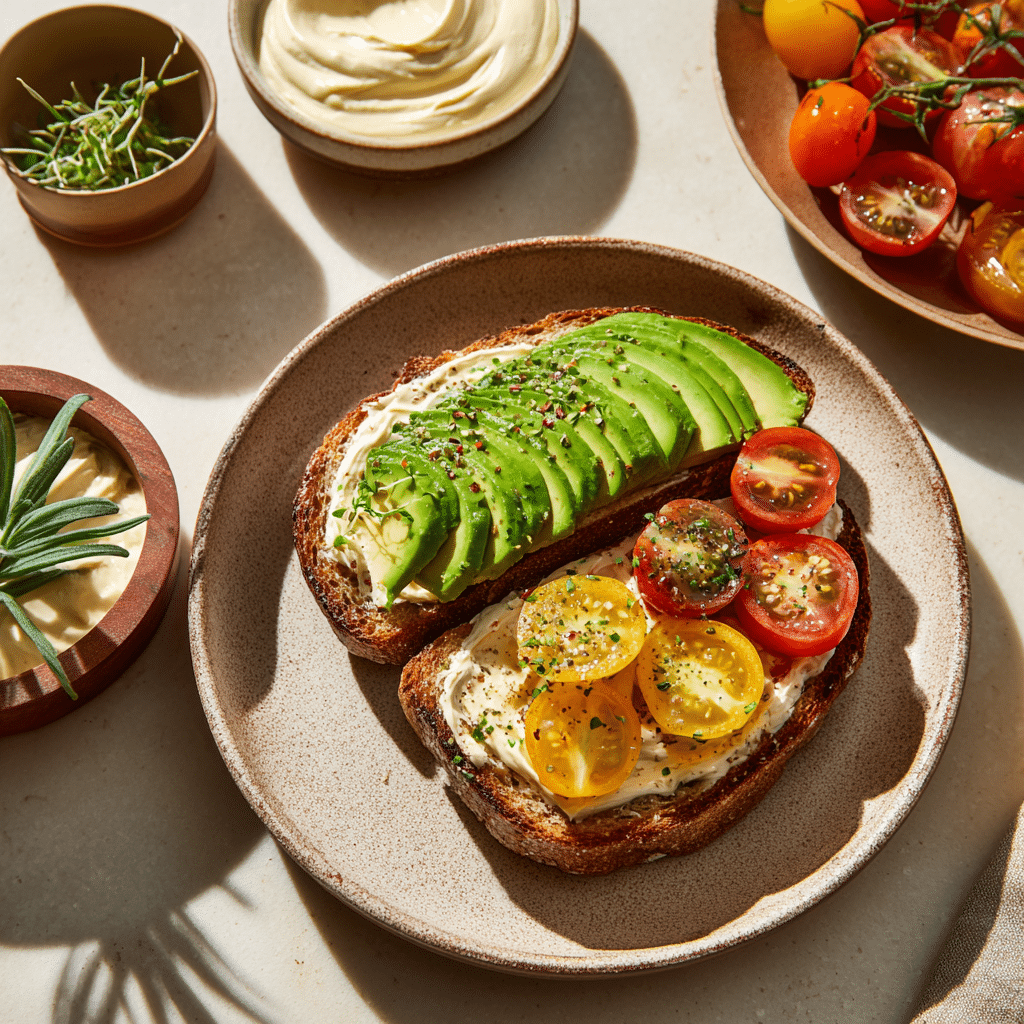
Fried egg mayonnaise isn’t just a quirky kitchen experiment—it’s a versatile spread that works across breakfast, lunch, and dinner. The savory depth from the cooked egg and creamy oil base makes it a perfect upgrade to plain mayo.
Here’s how to use it on toasts:
- Morning Boost: Spread on toasted sourdough with avocado, chili flakes, and microgreens.
- Hearty Breakfast: Layer it with bacon and tomatoes for a breakfast BLT twist.
- Open-Faced Sandwiches: Use it as a base for poached eggs, ham, or grilled vegetables.
For burgers and sandwiches, it’s a total game-changer:
- Spread a thick layer on both buns.
- Top with grilled chicken, beef patties, or fried tofu.
- Add lettuce, pickles, and a little Dijon-infused mayo for complexity.
The mayo’s slight chunkiness (from fried egg whites) adds texture, while the emulsified richness binds your ingredients like a gourmet sauce.
Using It as a Dip or Salad Dressing
Besides spreading, fried egg mayonnaise works beautifully as a dip or creamy base for dressings.
Dip Ideas:
- Fries & Chips: Serve chilled as a dip for sweet potato fries or kettle chips.
- Crudité Platter: Add fresh herbs and lemon juice to thin it slightly and pair with raw veggies.
Salad Uses:
- Use as a base for egg salad or potato salad—adds more richness than plain mayo.
- Mix it into cold pasta with peas, onions, and chopped bacon for a smoky mayo pasta salad.
- Blend with a little yogurt and vinegar to make a creamy dressing for coleslaw or cabbage slaw.
Its bold, savory undertones also make it a fantastic binder for wraps and stuffed pita sandwiches.
Tips and Troubleshooting
How to Avoid Curdling or Separation
One of the most common challenges in making fried egg mayonnaise is getting the emulsion to hold. Because you’re using cooked eggs instead of raw yolks, it behaves differently—and the mixture can split or curdle if you’re not careful.
Here’s how to prevent that:
- Let Eggs Cool First: Blending while eggs are still hot will cause the oil to separate.
- Use a Food Processor: Manual mixing may not break the egg pieces down enough for a smooth blend.
- Add Oil Slowly: Emulsions fail when oil is added too quickly. Drizzle it in very slowly while blending.
- Use an Emulsifier: Mustard and vinegar aren’t just for flavor—they help bind everything together.
- Don’t Overblend: Once the texture is smooth, stop blending. Overworking the mix can cause it to break.
Texture Fixes: When It’s Too Thick or Too Runny
Getting the right texture with fried egg mayonnaise can be tricky, especially since you’re working with cooked egg proteins.
Here’s how to troubleshoot common texture issues:
| Problem | Cause | Fix |
|---|---|---|
| Too Runny | Too much oil or hot eggs | Blend in another fried yolk or more mustard |
| Too Thick | Too much egg or not enough liquid | Add a few drops of lemon juice or warm water |
| Gritty Texture | Eggs overcooked or under-blended | Blend longer or strain the final mix |
| Oily Layer on Top | Emulsion broke during blending | Re-blend slowly with vinegar or mustard |
Pro Tip: If you prefer a silky texture, blend just the yolks and discard the whites. This trick works especially well if you’re using the mayo as a dip or salad dressing.
By managing these small adjustments, you can consistently produce fried egg mayo that’s just as satisfying—if not more so—than traditional versions.
Nutritional Breakdown and Dietary Considerations
Is Fried Egg Mayonnaise Healthy?
When people hear “fried egg” and “mayonnaise” in the same sentence, health might not be the first thing that comes to mind. But let’s break it down—fried egg mayonnaise can be a nutrient-dense and customizable condiment, depending on how you prepare it.
Here’s a basic nutritional estimate (per 1 tablespoon):
| Nutrient | Approximate Value |
|---|---|
| Calories | 90–100 kcal |
| Total Fat | 10g |
| Saturated Fat | 1.5g |
| Protein | 1g |
| Carbohydrates | 0g |
| Cholesterol | 45–60mg |
| Sodium | Varies by seasoning |
Much of the calorie content comes from oil—just like in traditional mayo. However, using light olive oil or avocado oil can increase the monounsaturated (heart-healthy) fats while keeping things flavorful.
Plus, since the eggs are cooked, this mayo avoids the food safety concerns of raw egg-based recipes. That makes it safer for pregnant women, kids, and older adults.
Want to make it lighter? Try this:
- Use less oil or blend in some Greek yogurt.
- Choose egg whites alone for a lighter option with less fat and cholesterol.
- Add flavor using fresh herbs instead of salt or sugar.
Keto-Friendly and Low-Carb Options
If you’re following a keto, paleo, or low-carb lifestyle, fried egg mayonnaise is a perfect fit. It’s:
- Zero-carb (if made without sugar or sweet additives)
- High in healthy fats, especially if you choose olive or avocado oil
- Packed with protein from eggs
- Free from processed additives and stabilizers
You can also personalize it with keto-friendly flavors:
- Garlic + Lemon for aioli-style mayo
- Paprika + Chili Oil for smoky heat
- Fresh Dill + Cucumber Juice for a creamy keto ranch alternative
It’s a smart, flavorful way to add richness to your meals without spiking carbs or sugars—and it adds a ton of satisfaction to otherwise lean plates.
FAQs
Can you make mayonnaise with fried eggs?
Yes, you can make a mayonnaise-style spread using fried eggs, though it won’t be a traditional emulsion. The cooked yolks and whites are blended with oil, lemon juice, and other seasonings to create a creamy, flavorful condiment. While not technically the same as raw-egg mayo, fried egg mayonnaise offers a richer, deeper taste with the bonus of being food-safe and fully cooked.
Can I make mayonnaise with cooked eggs?
Absolutely. Cooked eggs—whether fried, boiled, or poached—can be used to make mayonnaise-style spreads. While they don’t emulsify in the same way as raw yolks, they still create a creamy mixture when paired with oil and mustard or lemon juice. This method is perfect for anyone avoiding raw egg consumption.
For example, boiled egg mayonnaise is a popular version often used in deli-style sandwiches and salads.
How to make mayonnaise with just egg and oil?
To make mayonnaise using only egg and oil, you typically need a raw egg yolk. But for cooked versions like fried egg mayonnaise, you’ll blend 1–2 cooked (fried) eggs with a neutral oil—adding it slowly while blending. Though you’re missing traditional emulsifiers, you can still get a creamy consistency by:
-Using a food processor or immersion blender
-Adding a splash of vinegar or lemon juice
-Including a teaspoon of mustard for stability
This combo works great for simple mayo-like spreads that skip the raw egg risk.
How do I make egg mayonnaise?
Egg mayonnaise” usually refers to a spread made from chopped hard-boiled eggs and mayonnaise, not an emulsion itself. But you can adapt this by replacing store-bought mayo with your fried egg mayonnaise for a more rustic, homemade taste.
Here’s a quick egg mayo recipe using fried egg mayo:
2 hard-boiled eggs (chopped)
2 tablespoons fried egg mayonnaise
Salt, pepper, paprika, and optional chives
Mix well and spread on toast or sandwiches
It’s a fusion of egg salad and homemade mayo—packed with flavor and texture.
Conclusion
So, is fried egg mayonnaise worth the hype? Absolutely.
This unexpected twist on a classic condiment is rich, safe, and shockingly flavorful. Whether you’re trying to avoid raw eggs or just looking to level up your sandwich game, this mayo variant offers endless opportunities to experiment in the kitchen.
From its rustic texture to its bold, savory undertones, fried egg mayonnaise is more than a viral food trend—it’s a legit upgrade for your breakfast toast, burger spread, or salad dressing. With a little creativity and the right ingredients, you can transform a few fried eggs and some oil into a condiment that rivals the store-bought stuff.
So go ahead—fire up that pan, fry up some eggs, and blend your way to creamy greatness.
Don’t miss our recipes on Facebook.

